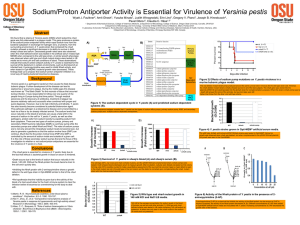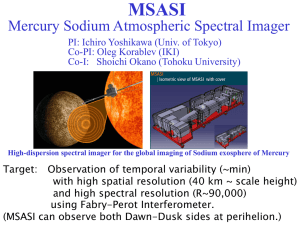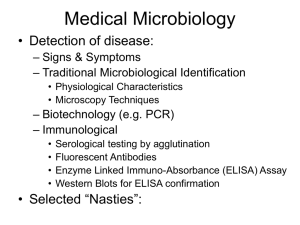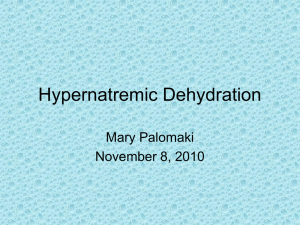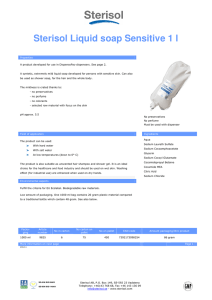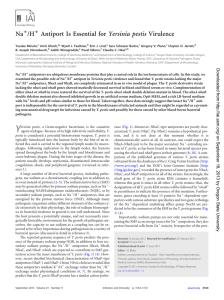View/Open - Oregon State University
advertisement
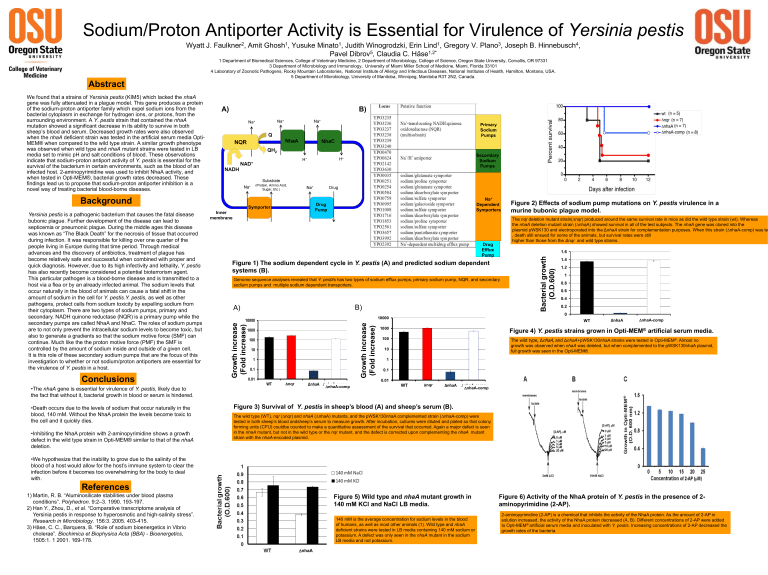
Sodium/Proton Antiporter Activity is Essential for Virulence of Yersinia pestis Wyatt J. Faulkner2, Amit Ghosh1, Yusuke Minato1, Judith Winogrodzki, Erin Lind1, Gregory V. Plano3, Joseph B. Hinnebusch4, Pavel Dibrov5, Claudia C. Häse1,2* 1 Department of Biomedical Sciences, College of Veterinary Medicine, 2 Department of Microbiology, College of Science, Oregon State University, Corvallis, OR 97331 3 Department of Microbiology and Immunology, University of Miami Miller School of Medicine, Miami, Florida 33101 4 Laboratory of Zoonotic Pathogens, Rocky Mountain Laboratories, National Institute of Allergy and Infectious Diseases, National Institutes of Health, Hamilton, Montana, USA. 5 Department of Microbiology, University of Manitoba, Winnipeg, Manitoba R3T 2N2, Canada. Abstract A) B) Primary Sodium Pumps Secondary Sodium Pumps Conclusions •The nhaA gene is essential for virulence of Y. pestis, likely due to the fact that without it, bacterial growth in blood or serum is hindered. •Death occurs due to the levels of sodium that occur naturally in the blood, 140 mM. Without the NhaA protein the levels become toxic to the cell and it quickly dies. •Inhibiting the NhaA protein with 2-aminopyrimidine shows a growth defect in the wild type strain in Opti-MEM® similar to that of the nhaA deletion. Symporter Inner membrane 1.6 Figure 1) The sodium dependent cycle in Y. pestis (A) and predicted sodium dependent systems (B). Genome sequence analyses revealed that Y. pestits has two types of sodium efflux pumps, primary sodium pump, NQR, and secondary sodium pumps and multiple sodium dependent transporters. B) A) 1000 100 10 1 0.1 0.01 WT Δnqr ΔnhaA DnhaA-comp DnhaA-comp 1.4 1.2 1 0.8 0.6 0.4 0.2 0 10000 10000 Figure 2) Effects of sodium pump mutations on Y. pestis virulence in a murine bubonic plague model. The nqr deletion mutant strain(Dnqr) produced around the same survival rate in mice as did the wild type strain (wt). Whereas the nhaA deletion mutant strain (DnhaA) showed survival in all of the test subjects. The nhaA gene was cloned into the plasmid pWSK130 and electroporated into the ΔnhaA strain for complementation purposes. When this strain (DnhaA-comp) was te , death still ensued for some of the animals, but survival rates were still higher than those from the Δnqr and wild type strains. Drug Efflux Pump Growth increase (Fold increase) Yersinia pestis is a pathogenic bacterium that causes the fatal disease bubonic plague. Further development of the disease can lead to septicemia or pneumonic plague. During the middle ages this disease was known as “The Black Death” for the necrosis of tissue that occurred during infection. It was responsible for killing over one quarter of the people living in Europe during that time period. Through medical advances and the discovery of antibiotics, treatment of plague has become relatively safe and successful when combined with proper and quick diagnosis. However, due to its high infectivity and lethality, Y. pestis has also recently become considered a potential bioterrorism agent. This particular pathogen is a blood-borne disease and is transmitted to a host via a flea or by an already infected animal. The sodium levels that occur naturally in the blood of animals can cause a fatal shift in the amount of sodium in the cell for Y. pestis.Y. pestis, as well as other pathogens, protect cells from sodium toxicity by expelling sodium from their cytoplasm. There are two types of sodium pumps, primary and secondary. NADH quinone reductase (NQR) is a primary pump while the secondary pumps are called NhaA and NhaC. The roles of sodium pumps are to not only prevent the intracellular sodium levels to become toxic, but also to generate a gradients so that the sodium motive force (SMF) can continue. Much like the the proton motive force (PMF) the SMF is controlled by the amount of sodium inside and outside of a given cell. It is this role of these secondary sodium pumps that are the focus of this investigation to whether or not sodium/proton antiporters are essential for the virulence of Y. pestis in a host. Drug Pump Bacterial growth (O.D.600) Background Na+ Dependent Symporters Growth increase (Fold increase) We found that a strains of Yersinia pestis (KIM5) which lacked the nhaA gene was fully attenuated in a plague model. This gene produces a protein of the sodium-proton antiporter family which expel sodium ions from the bacterial cytoplasm in exchange for hydrogen ions, or protons, from the surrounding environment. A Y. pestis strain that contained the nhaA mutation showed a significant decrease in its ability to survive in both sheep’s blood and serum. Decreased growth rates were also observed when the nhaA deficient strain was tested in the artificial serum media OptiMEM® when compared to the wild type strain. A similar growth phenotype was observed when wild type and nhaA mutant strains were tested in LB media set to mimic pH and salt conditions of blood. These observations indicate that sodium-proton antiport activity of Y. pestis is essential for the survival of the bacterium in certain environments, such as the blood of an infected host. 2-aminopyrimidine was used to inhibit NhaA activity, and when tested in Opti-MEM®, bacterial growth rates decreased. These findings lead us to propose that sodium-proton antiporter inhibition is a novel way of treating bacterial blood-borne diseases. WT ΔnhaA DnhaA-comp ΔnhaA+pWSK130nhaA 1000 Figure 4) Y. pestis strains grown in Opti-MEM® artificial serum media. 100 The wild type, ΔnhaA, and ΔnhaA+pWSK130nhaA strains were tested in Opti-MEM®. Almost no growth was observed when nhaA was deleted, but when complemented to the pWSK130nhaA plasmid, full growth was seen in the Opti-MEM®. 10 1 0.1 0.01 WT Δnqr ΔnhaA DnhaA-comp DnhaA-comp Figure 3) Survival of Y. pestis in sheep’s blood (A) and sheep’s serum (B). The wild type (WT), nqr (Dnqr) and nhaA (DnhaA) mutants, and the pWSK130nhaA complemented strain (DnhaA-comp) were tested in both sheep’s blood andsheep’s serum to measure growth. After incubation, cultures were diluted and plated so that colony forming units (CFU) couldbe counted to make a quantitative assessment of the survival that occurred. Again a major defect is seen in the nhaA mutant, but not in the wild type or the nqr mutant, and the defect is corrected upon complementing the nhaA mutant strain with the nhaA-encoded plasmid. •We hypothesize that the inability to grow due to the salinity of the blood of a host would allow for the host’s immune system to clear the infection before it becomes too overwhelming for the body to deal with. References 1) Martin, R. B. “Aluminosilicate stabilities under blood plasma conditions”. Polyhedron. 9:2–3. 1990. 193-197. 2) Han Y., Zhou, D., et al. “Comparative transcriptome analysis of Yersinia pestis in response to hyperosmotic and high-salinity stress”. Research in Microbiology. 156:3. 2005. 403-415. 3) Häse, C. C., Barquera, B. “Role of sodium bioenergetics in Vibrio cholerae”. Biochimica et Biophysica Acta (BBA) - Bioenergetics, 1505:1. 1 2001. 169-178. Figure 5) Wild type and nhaA mutant growth in 140 mM KCl and NaCl LB media. 140 mM is the average concentration for sodium levels in the blood of humans, as well as most other animals (1). Wild type and nhaA deficient strains were tested in LB media containing 140 mM sodium or potassium. A defect was only seen in the nhaA mutant in the sodium LB media and not potassium. DnhaA Figure 6) Activity of the NhaA protein of Y. pestis in the presence of 2aminopyrimidine (2-AP). 2-aminopyrimidine (2-AP) is a chemical that inhibits the activity of the NhaA protein. As the amount of 2-AP in solution increased, the activity of the NhaA protein decreased (A, B). Different concentrations of 2-AP were added to Opti-MEM® artificial serum media and inoculated with Y. pestis. Increasing concentrations of 2-AP decreased the growth rates of the bacteria. + Na + Na + Na Q NhaA NQR NhaC QH2 + H + H + NAD NADH Substrate + Na (Protein, Amino Acid, Sugar, Etc.) + Na Drug
